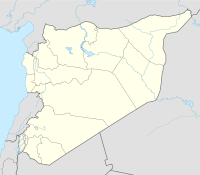| Dura-Europos church | |
|---|---|
 Isometric drawing of the church | |
| 34°44′45″N 40°43′41″E / 34.745829°N 40.727958°E | |
| Location | Dura-Europos |
| Country | |
| Denomination | Early Christianity |
| History | |
| Status | Inactive |
| Founded | 233 |
| Relics held | Mosaics |
| Architecture | |
| Functional status | Ruins (possibly destroyed) |
| Style | House church |
| Completed | 233 AD |
| Demolished | 256 AD (abandoned) |

The Dura-Europos church (or Dura-Europos house church) is the earliest identified Christian house church.[1] It was located in Dura-Europos, Syria, and one of the earliest known Christian churches.[2] It is believed to have been an ordinary house that was converted to a place of worship between 233 and 256 AD, and appears to have been built following the Durene tradition, distinguished by the use of mud brick and a layout consisting of rooms encircling a courtyard, which was characteristic of most other homes built in the Dura-Europos region.[3] Prior to the town being abandoned in 256 during the Persian siege, the Romans built a ramp extending from the city wall which buried the church building in a way that allowed for the preservation of its walls, enabling its eventual excavation by archaeologists in 1933.[4][5][6] It was less famous, smaller, and more-modestly decorated than the nearby Dura-Europos synagogue, though there are many similarities between them.
The church was uncovered by a French-American team of archaeologists during two excavation campaigns in the city from 1931-32. The frescos were removed after their discovery and are preserved at Yale University Art Gallery.[7]
The fate of the church after the occupation of Syrian territory by ISIL during the Syrian Civil War is unknown; it is assumed the building was destroyed.[8][9]
- ^ Snyder 2003, p. 128.
- ^ Snyder 2005, p. 30.
- ^ Brody & Hoffman 2011, p. 155.
- ^ Floyd V. Filson (June 1939). "The Significance of the Early House Churches". Journal of Biblical Literature. 58 (2): 105–112. doi:10.2307/3259855. JSTOR 3259855.
- ^ Brody & Hoffman 2011, p. 156.
- ^ Fischer 1955.
- ^ "Dura-Europos: Excavating Antiquity | Yale University Art Gallery". media.artgallery.yale.edu.
- ^ Curry, Andrew (September 1, 2015). "Here Are The Ancient Sites ISIS Has Damaged and Destroyed". National Geographic. National Geographic Society. Archived from the original on 2019-08-13. Retrieved December 25, 2020.
- ^ Peppard, Michael (2016-01-07). "ISIS seeks to control the country's future by destroying its Christian past". America Magazine. Retrieved 2024-08-02.
